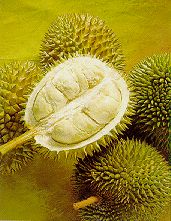Durian—The Real Forbidden Fruit
In The Malay Archipelago, famed Victorian naturalist and evolutionary theorist Alfred Russell Wallace wrote, "To eat durian is a new sensation worth a voyage to the East to experience." Roughly 150 years later, some adventurous members of the science department at BBG, including yours truly, decided to test his assertion.
So on a sunny June afternoon, we piled into a staff car and headed due east on Montgomery Street. But not for long! We soon turned right and right again and headed southwest toward Sunset Park, Brooklyn. That's because we knew that the Asian fruit markets there would be selling imported durian for about a dollar a pound.

Okay, we weren't being quite as intrepid as Wallace, who spent eight years exploring Malaysia and Indonesia in the days before the steamboat, but we were still on a voyage of discovery of sorts and feeling quite a rush of nervous excitement. None of us had ever tasted durian, the so-called king of fruits. Indeed, none of us had ever seen—or smelled—one in the flesh. But we were prepared for the worst!
The durian tree (Durio zibethius) is native to moist equatorial forests in southeast Asia. It grows to 100 feet tall and produces heavy, thick-skinned, brownish-green, soccer-ball-size fruits covered with short, sharp spikes (duri is the Malaysian word for "thorn"). When ripe, these hedgehog-like fruits fall hard and fast to the ground—and hikers are advised to get out the way.
Individual fruits are divided into five compartments, each containing a large brown seed covered by a sac of thick, creamy, yellow pulp with an aroma that's legendary. You could publish a small book full of analogies that have been used to try to pin down this odor. Some of the more common comparisons include overripe cheese, fermented onions, rotten fish, and unwashed socks. (The bad smell, of course, performs a very important function: It attracts jungle animals to the fruit to facilitate seed dispersal.)
Combine the unpleasant odor with the fruit's rich, almond-sweet flavor and puddinglike texture, and you have a culinary experience that's been described in one respected book on tropical crops—written, wouldn't you know, by a Westerner—as "French custard passed through a sewer." But it's an experience that many people in Thailand, Malaysia, Singapore, and Indonesia appreciate and crave.
Besides eating durian raw, the inhabitants of these countries use it to make soup, candy, pastries, and ice cream. They also eat the seeds, usually sliced and fried in oil. A traditional way of preparing durian is to cook it with sticky rice and sugar in coconut milk, which apparently helps neutralize the unpleasant pong.
Durian is a nutritious food, packed with minerals, proteins, and fats. (I've also read that it's prized in the East as an aphrodisiac, presumably by foot fetishists.) Of course, just because these folks like to eat durian doesn't mean that they want to breathe its fetid fumes for very long. In at least one of these countries—Singapore—it's forbidden to carry durian on any kind of public transportation.
Deforestation has led to a decline in wild durian populations. The fruit is cultivated in orchards, and numerous varieties are available. However, because it takes ten years for a durian tree to come to fruition, farming hasn't exactly proliferated. Consequently, durians are becoming scarcer year by year, as well as more and more expensive.
Still, when we arrived at Sunset Park, we were perfectly willing to fork out the big bucks for a specimen. We didn't get much help choosing a fruit from the market attendant, who seemed just as baffled by what he was selling as we were. None of the durians on display seemed particularly outstanding, so we just picked one and started back. We didn't notice much of an odor in the car, or if we did it wasn't clear whether the source was the durian or something more mundane (it was a warm day and we were all wearing socks!).
The tag on the bag told us that we'd just bought a Monthong, which is a popular durian variety grown commercially in Thailand and exported worldwide. On returning to home base, a large group of taste testers assembled in the kitchen of the Science Building to give it a try. Using a knife, we split the fruit along its natural lines of separation, pulling open the rind to reveal the yellow flesh inside.
"It's like some alien pod creature from The X-Files," someone quipped. And all of a sudden we could smell it. Onions, onions, onions...somewhat overcooked, somewhat abominable.
Plates and forks were passed around quickly, and some tentative nibbling took place. A security guard walked 20 yards down the hall from his post to investigate the increasingly potent perfume.
"It tastes like it looks," volunteered one unhappy experimenter. But that wasn't necessarily the general consensus. Yes, the durian was rather malodorous. But some of us who held it on our tongues for a while tasted something sweetly strange, otherworldly, and inviting. It didn't seem implausible, given time, and lots of cash, that we could come to love it too.


